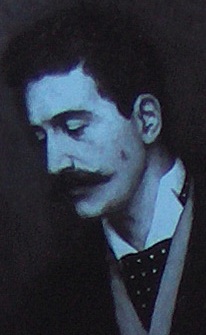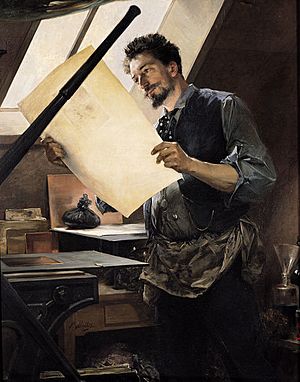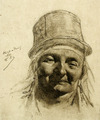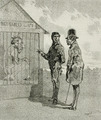Félicien Rops facts for kids
Quick facts for kids
Félicien Rops
|
|
|---|---|

Detail from The Members of the
Société Libre des Beaux-Arts by Edmond Lambrichs |
|
| Born | 7 July 1833 Namur, Belgium
|
| Died | 23 August 1898 (aged 65) Essonnes, France
|
| Nationality | Belgian |
| Known for | Print making, intaglio, illustrations, drawing, painting |
|
Notable work
|
Pornocrates Les Sataniques Les Diaboliques |
| Movement | Symbolism, Decadent movement, Fin de siècle |
Félicien Victor Joseph Rops (born July 7, 1833 – died August 23, 1898) was a Belgian artist. He was a talented painter, illustrator, and caricaturist. Rops was also a very creative and active print maker. Even though many people don't know his name, other artists and writers respected him greatly. Publishers and poets of his time loved his illustrations. Rops is even known as one of the first artists in Belgian comics.
Contents
About Félicien Rops
Early Life and School (1833–1857)
Félicien Rops was born on July 7, 1833, in Namur, Belgium. He was the only child of Sophie Maubile and Nicholas Rops. His family was quite rich because they made textiles. Félicien was taught at home by private teachers until he was ten.
In 1843, he started at a local Jesuit school for five years. He was very smart and could recite long parts of the Bible in Latin. But even as a student, he loved to draw funny pictures of his teachers. His family said he "began to let fantasy dominate his thinking."
His father, Nicholas Rops, died in 1849. After some talks with his mother about his future, Félicien joined the Athénée secondary school in Namur in June 1849. At the same time, he also went to the Academy of Fine Arts there.
In 1851, Rops moved to Brussels to study law at the University of Brussels. But by 1853, he was studying drawing at the Académie de Saint-Luc. He became very skilled at drawing from live models. There, he met other artists like Louis Artan and Constantin Meunier. He also joined the local art scene.
During this time, he started drawing funny pictures and satirical lithographs for student magazines. One magazine, Le Crocodile, made him quite famous. In 1856, Rops and his friends started their own weekly magazine called The Uylenspiegel. He drew one or two lithographs for almost every issue, making over 180 in total. This helped his reputation grow even more.
Starting His Career in Belgium (1857–1870)
In June 1857, Rops married Charlotte Polet de Faveaux. Her father was a rich judge and owned Thozée Castle in the countryside near Mettet, Belgium. For the first few years at Thozée, Rops lived a comfortable life. He enjoyed painting, studying plants, and even started a rowing club in 1862. He often spoke highly of his father-in-law.
Rops and Charlotte had a son, Paul, in 1858, and a daughter, Juliet, in 1859. Sadly, Juliet died when she was five. Rops stopped being a manager at Uylenspiegel but kept drawing cartoons and illustrations until 1862. He began to learn about etching and made political lithographs. He also drew pictures for books, including some for Charles De Coster's La Légende d'Uylenspiegel (1867).
His home became a place where artists, writers, and friends gathered. In 1868, the Société Libre des Beaux-Arts (Free Society of Fine Arts) was started in Brussels. Rops was the Vice-President for several years. By the 1860s, Rops was traveling a lot. He spent time in Thozée Castle, Namur, Brussels, and Paris each year. He spent more and more time in Paris, which was a center for art and literature.
In 1862, he learned etching from Félix Bracquemond in Paris. He loved to try new etching methods. Later, with his friend Armand Rassenfosse, they created a new technique called "Ropsenfosse." By 1865, he stopped making lithographs. Even though he still painted with oil, etching became his main art form. He created 34 front pages for books between 1864 and 1870. He also started a group called the International Society of Etchers (1869–1871), but it didn't last long.
Later Years in Paris (1871–1898)
By 1875, Félicien and Charlotte were living apart, but they never divorced. Rops became very successful among the artists and poets in Paris. His reputation grew, and there was a high demand for his illustrations. In 1877, he proudly said he was "the best-paid illustrator in France."
He traveled widely across Europe, visiting big cities and art centers. He even went salmon fishing in Norway and Sweden, and explored Hungary, Spain, and North Africa. Rops often showed his art at the salons in Paris. People were both amazed and surprised by his work.
In 1883, Rops was asked to join Les XX (The Twenty), a group of Belgian artists. This group held yearly art shows and concerts in Brussels. Les Vingt supported new and modern artists for 10 years. The French poet Stéphane Mallarmé held talks about art and literature at his home in Paris. Many famous writers and artists, including Rops, Paul Gauguin, and Édouard Manet, attended these talks.
Rops stayed connected with writers until the end of his life. In 1896, a literary magazine called "La Plume" published a special issue about Rops. Many important authors and artists praised his work in it. Félicien Rops was also a freemason.
In 1892, Rops had an accident that almost made him lose his eyesight, but he got better. His health slowly got worse, so he spent some time in the warmer climate of southern France. Rops died on August 23, 1898, at his home. He was first buried in Essonnes, but his body was moved to his family's burial ground in Namur, Belgium, eight years later. The next year, he received the Legion of Honour award after his death.
Today, there is a museum called Musée Félicien Rops in his hometown of Namur, Belgium. It has about 3,000 engravings and 500 drawings and paintings. Rops also wrote many letters. The Félicien Rops Museum has found and listed over 4,000 letters. These letters are important because they tell us a lot about Rops and other artists, writers, and cultural figures of the late 1800s in Europe.
Rops's Art Style
Félicien Rops was a very active and diverse artist. He created fine art, but also hundreds of comics, caricatures, and book illustrations. His style could change from realism (showing things as they truly are) to symbolism (using symbols to represent ideas). Sometimes, his art even touched on romanticism and impressionism.
His pictures could show country scenes or city life. They could be social or political comments, sometimes kind, sometimes sharp. His art could be like a documentary or a fantasy. It ranged from poetic and symbolic to very realistic. For example, three of his etchings of animals show how many different styles he used. Japanese Salamander and Beetle is a simple, decorative study of nature. The Cat looks like a pleasant cat, but the words on the chair say "Amica Non Serva" (Friend Not Servant), giving the image a deeper meaning.
Rops was interested in everyday life scenes throughout his career. He often drew and etched people from the Walloon region of Belgium, showing them simply and kindly. Older people appeared often in his works, like Old Kate. Rops also drew people he met on his travels, showing their traditional clothes. He once wrote that he wanted to show "the scenes and characters of the 19th century that I find so fascinating and curious."
Paintings and Drawings
Rops's oil paintings show many different subjects and styles. They include still life paintings, street scenes like Entrance to the Ball, and many landscapes. He painted landscapes throughout his life, often small paintings done outdoors. Examples like The Rocks of the Grands Malades and Snow in Thozée were painted near his hometown of Namur. You can see the influence of artists like Jean-Baptiste-Camille Corot in many of his landscapes. Living in Paris, Rops met many artists and saw different art styles. You can see parts of impressionism in The Beach in Heist, which he painted on the Belgian coast.
Prints and Book Illustrations
Rops was a printmaker with amazing skill and original ideas. He was a master of using dry point, a technique where you draw directly onto the printing plate. Even though Rops worked in many different art forms, printmaking was his main way of expressing himself. He used lithography, wood engraving, etching, and many other techniques. He made hundreds of prints in his life. His prints are very varied and show all the styles and subjects he explored.
He started focusing on intaglio (a type of printmaking) in the 1860s. He learned etching from Félix Bracquemond in Paris. Félix Bracquemond was important in bringing back interest in etching among artists. By the end of the 1860s, Rops had almost stopped using lithography. Rops started the International Society of Etchers around 1869 or 1870. Even though artists and royalty praised the society, he found it hard to keep it going for more than two or three years.
Rops loved the process of printmaking and was always trying new techniques. From the early 1870s, he started using soft-ground etching, a technique few artists used. He often mixed it with other methods like mezzotint and aquatint. Sometimes, he even added hand-coloring to the prints. He also used a photo-mechanical process (heliogravure) to transfer his drawings to printing plates. Then, he would add more details using other techniques. Because traditional soft-ground methods didn't work well for him, he and his friend Armand Rassenfosse invented their own process called "Ropsenfosse." This was likely the first soft-ground method used to make color prints with more than one plate.
His etchings were very popular. Many modern writers, poets, and publishers of the late 1800s wanted him to illustrate their books. His prints were widely shared in the books he illustrated. They influenced many younger artists, including Symbolists and Expressionists like Max Beckmann and Edvard Munch.
Images for kids
-
Louis Defré (also known as Maurice Voituron & Joseph Boniface), mayor of Uccle (1858)
See also
 In Spanish: Félicien Rops para niños
In Spanish: Félicien Rops para niños


































